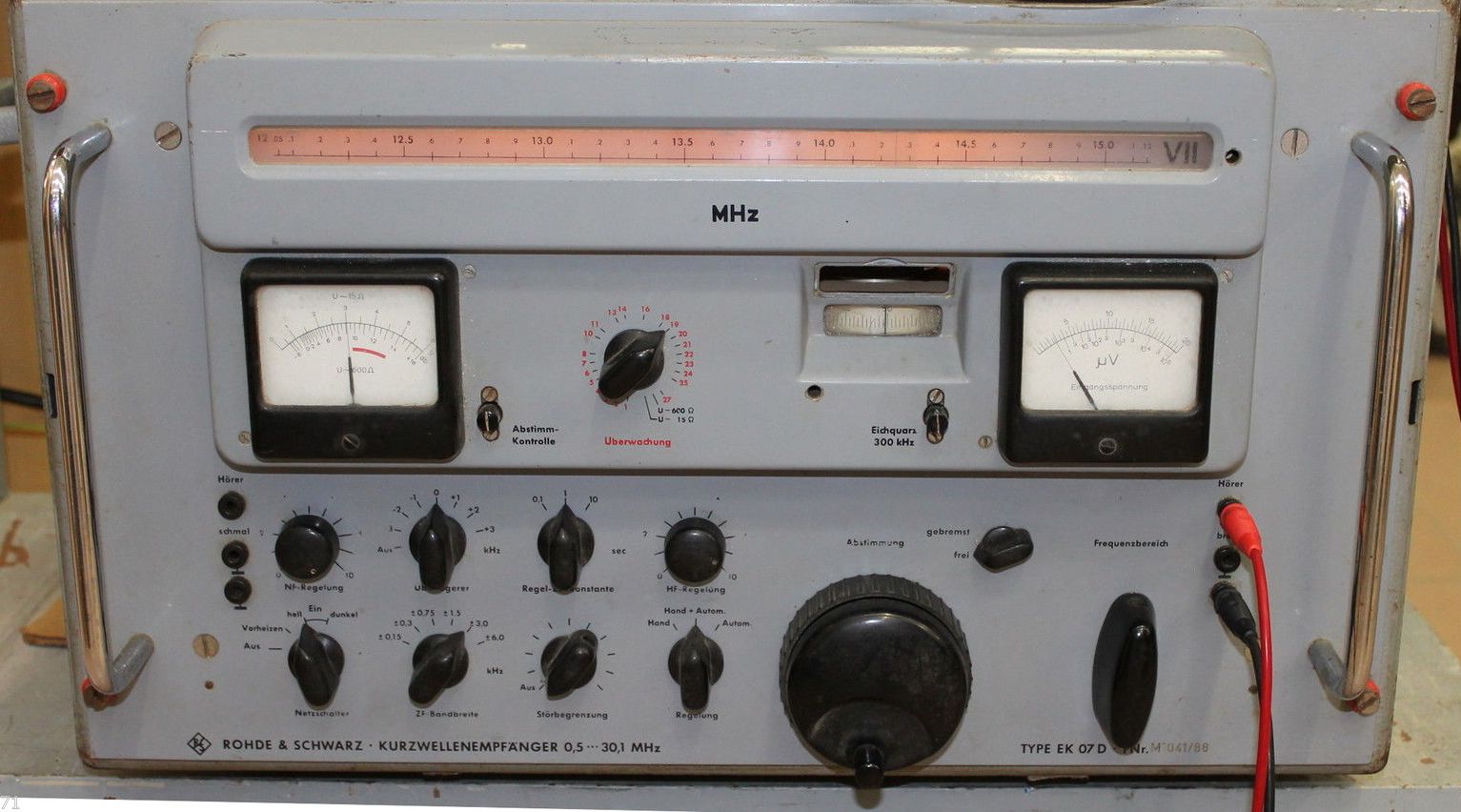Marine Receiver – Rohde & Schwarz EK 07
Dear Sparks,
on this review it is remembered one of the Rohde & Schwarz “Excellence” the receiver model EK 07, employed in several services, it found a great place in the marine communications and it has been for several years the receiver used in Norddeich Radio and other German coast radio stations as shown in the clip below, two clips are showed, in the second one an EK07 under tests.
| Double conversion superhet, 1st I.F. 3,3 MHz, 2nd I.F. 300 kHz
Analog dial, linear, accuracy ca. 1 kHz, coverage 500 kHz – 30,1 MHz AM, CW, SSB Selectivity -6 dB |
|
With it’s dimensions of 54 x 33 x 55 cm (frontpanel width is a bit more then the standard 19 inch rack) and it’s weight of 66,3 kg, the Rohde & Schwarz EK 07 is not only another huge receiver, it’s bigger and heavier then the Collins R-390 or the Siemens E-311, only Telefunken’s E-104 is quite a bit bulkier and heavier… But it’s good to have two handles on each side of the cabinet, to get it lifted up on my shelves, I needed the help of my oldest son, my wife considered the thing as a bit to heavy…
The receiver can be powered from different mains voltages from 110 – 235 V and has a power consumption of 130 Watts to keep all 27 tubes glowing.
The frontpanel with the two protection handles is dominated by the very impressive 34 cm wide dial window between the two large format instruments, below the mainfrequency dial with a turret arrangement, You find the small window for the kHz indicator dial and below all other controls, the huge main tuning knob and the band selector switch activating theturret tuner arrangement.
The band selector switches the separate shortwave bands, each of them in most cases three MHz wide, in the dial window, the respective part of the shortwave dial drum will be visible.
The receiver is tuned with main tuning knob, it’s outer ring has a 30:1 gear for fine tuning, the complete tuning mechanism can be blocked mechanically.
The left measuring instrument will display the A.F. level in position “600 Ohm” and the speaker output in position “16 Ohm”. The right instrument will display the R.F. level in uV. Just next to the signal strength meter, You find a small pushbutton whick can be turned 90 dregrees when depressed to lock, it will activate the 300 kHz crystal calibrator.
The R.F. signal coming from the antenna will first have to pass an automatic preselection stage with twelve passbands and after an amplifier stage a synchroneously tunes band pass. After this, it will be mixed to a first intermediate frequency of 3,3 MHz in the ranges V – XII and then to the second i.f. of 300 kHz, below 6 MHz, the signal is directly mixed to 300 kHz as first intermediate frequency. After having passed several amplifier stages and the i.f. filters for the six bandwidths, the signal is fed to the demodulator stage after the AGC control voltage has been generated.
A diode demodulator is active for AM demodulation, for single sideband and CW operation, a BFO can be activated. There existed a mechanical remote control machine to control the EK 07 over telephone lines, control pulses did activate small motors which moved the frontpanel controls.
In practical use, the Rohde & Schwarz EK 07 is a strong competitor to other high end shortwave receivers from the sixties, it has a similar performance as the Collins R-390A, at least as fas as Am and CW reseption is concerned. Like with the Collins R-390, You need the optional single sideband demodulator for perfect single sideband demodulation, otherwise SSB performance is only fair when done with the internal BFO. But one has to remember, in most other receivers from that era, a BFO for SSB reception was all, the set did offer – Rohde & Schwarz did offer more, for another sum of money. So You could get, what money could buy in those years.
The receiver is quite resistant to overload and free of unwanted signals thanks to the automatic preselection; it has a very high stability and a very good dial accuracy with a dial resolution of better then 1 kHz.
Like with other commercial receivers from the fifties and sixties, the receiver is not equipped with the features to reject interfering signals such as a passband tuning or notch filter.
73’s
webmaster
